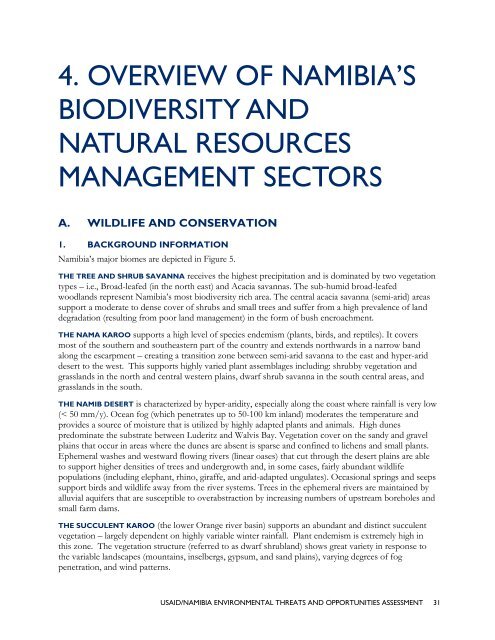usaid/nambia environmental threats and opportunities assessment
usaid/nambia environmental threats and opportunities assessment
usaid/nambia environmental threats and opportunities assessment
Create successful ePaper yourself
Turn your PDF publications into a flip-book with our unique Google optimized e-Paper software.
4. OVERVIEW OF NAMIBIA’S<br />
BIODIVERSITY AND<br />
NATURAL RESOURCES<br />
MANAGEMENT SECTORS<br />
A. WILDLIFE AND CONSERVATION<br />
1. BACKGROUND INFORMATION<br />
Namibia’s major biomes are depicted in Figure 5.<br />
THE TREE AND SHRUB SAVANNA receives the highest precipitation <strong>and</strong> is dominated by two vegetation<br />
types – i.e., Broad-leafed (in the north east) <strong>and</strong> Acacia savannas. The sub-humid broad-leafed<br />
woodl<strong>and</strong>s represent Namibia’s most biodiversity rich area. The central acacia savanna (semi-arid) areas<br />
support a moderate to dense cover of shrubs <strong>and</strong> small trees <strong>and</strong> suffer from a high prevalence of l<strong>and</strong><br />
degradation (resulting from poor l<strong>and</strong> management) in the form of bush encroachment.<br />
THE NAMA KAROO supports a high level of species endemism (plants, birds, <strong>and</strong> reptiles). It covers<br />
most of the southern <strong>and</strong> southeastern part of the country <strong>and</strong> extends northwards in a narrow b<strong>and</strong><br />
along the escarpment – creating a transition zone between semi-arid savanna to the east <strong>and</strong> hyper-arid<br />
desert to the west. This supports highly varied plant assemblages including: shrubby vegetation <strong>and</strong><br />
grassl<strong>and</strong>s in the north <strong>and</strong> central western plains, dwarf shrub savanna in the south central areas, <strong>and</strong><br />
grassl<strong>and</strong>s in the south.<br />
THE NAMIB DESERT is characterized by hyper-aridity, especially along the coast where rainfall is very low<br />
(< 50 mm/y). Ocean fog (which penetrates up to 50-100 km inl<strong>and</strong>) moderates the temperature <strong>and</strong><br />
provides a source of moisture that is utilized by highly adapted plants <strong>and</strong> animals. High dunes<br />
predominate the substrate between Luderitz <strong>and</strong> Walvis Bay. Vegetation cover on the s<strong>and</strong>y <strong>and</strong> gravel<br />
plains that occur in areas where the dunes are absent is sparse <strong>and</strong> confined to lichens <strong>and</strong> small plants.<br />
Ephemeral washes <strong>and</strong> westward flowing rivers (linear oases) that cut through the desert plains are able<br />
to support higher densities of trees <strong>and</strong> undergrowth <strong>and</strong>, in some cases, fairly abundant wildlife<br />
populations (including elephant, rhino, giraffe, <strong>and</strong> arid-adapted ungulates). Occasional springs <strong>and</strong> seeps<br />
support birds <strong>and</strong> wildlife away from the river systems. Trees in the ephemeral rivers are maintained by<br />
alluvial aquifers that are susceptible to overabstraction by increasing numbers of upstream boreholes <strong>and</strong><br />
small farm dams.<br />
THE SUCCULENT KAROO (the lower Orange river basin) supports an abundant <strong>and</strong> distinct succulent<br />
vegetation – largely dependent on highly variable winter rainfall. Plant endemism is extremely high in<br />
this zone. The vegetation structure (referred to as dwarf shrubl<strong>and</strong>) shows great variety in response to<br />
the variable l<strong>and</strong>scapes (mountains, inselbergs, gypsum, <strong>and</strong> s<strong>and</strong> plains), varying degrees of fog<br />
penetration, <strong>and</strong> wind patterns.<br />
USAID/NAMIBIA ENVIRONMENTAL THREATS AND OPPORTUNITIES ASSESSMENT 31

















